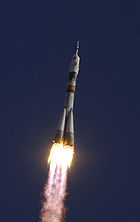| This article needs additional citations for verification. Please help improve this article by adding citations to reliable sources. Unsourced material may be challenged and removed. Find sources: "Voskhod" rocket – news · newspapers · books · scholar · JSTOR (August 2014) (Learn how and when to remove this message) |
 Voskhod rocket Voskhod rocket | |
| Function | Crew-rated LEO carrier rocket |
|---|---|
| Manufacturer | OKB-1 |
| Country of origin | Soviet Union |
| Size | |
| Height | 30.84 m (101.2 ft) |
| Diameter | 2.99 m (9.8 ft) |
| Mass | 298,400 kg (657,900 lb) |
| Stages | 2 |
| Capacity | |
| Payload to LEO | |
| Mass | 5,900 kg (13,000 lb) |
| Associated rockets | |
| Family | R-7 |
| Launch history | |
| Status | Retired |
| Launch sites | Baikonur Site 1 and Site 31 Plesetsk, Site 41 |
| Total launches | 300 |
| Success(es) | 287 |
| Failure(s) | 13 |
| First flight | 16 November 1963 |
| Last flight | 29 June 1976 |
| Type of passengers/cargo | Voskhod spacecraft Zenit (satellite) |
| Boosters | |
| No. boosters | 4 |
| Powered by | 1 RD-107 |
| Maximum thrust | 995.4 kN (223,800 lbf) |
| Total thrust | 3,981.6 kN (895,100 lbf) |
| Specific impulse | 257 seconds (2.52 km/s) |
| Burn time | 119 seconds |
| Propellant | RP-1 / LOX |
| First stage | |
| Powered by | 1 RD-108 |
| Maximum thrust | 941 kN (212,000 lbf) |
| Specific impulse | 248 seconds (2.43 km/s) |
| Burn time | 301 seconds |
| Propellant | RP-1 / LOX |
| Second stage | |
| Powered by | 1 RD-0107 |
| Maximum thrust | 294 kN (66,000 lbf) |
| Specific impulse | 330 seconds (3.2 km/s) |
| Burn time | 240 seconds |
| Propellant | RP-1 / LOX |
| [edit on Wikidata] | |
The Voskhod rocket (Russian: Восход, "ascent", "dawn") was a derivative of the Soviet R-7 ICBM designed for the human spaceflight programme but later used for launching Zenit reconnaissance satellites. It was essentially an 8K78/8K78M minus the Blok L stage and spec-wise was a halfway between the two boosters, with the former's older, lower-spec engines and the latter's improved Blok I design. Its first flight was on 16 November 1963 when it successfully launched a Zenit satellite from LC-1/5 at Baikonur. Boosters used in the Voskhod program had a man-rated version of the RD-0107 engine; this version was known as the RD-0108.
Starting in 1966, the 11A57 adopted the standardized 11A511 core with the more powerful 8D74M first stage engines, however the Blok I stage continued using the RD-0107 engine rather than the RD-0110. Around 300 were flown from Baikonur and Plesetsk through 1976, almost all of them used to launch Zenit reconnaissance satellites (one exception was the Intercosmos 6 satellite in 1973).
The newer 11A511U core had been introduced in 1973, but the existing stock of 11A57s took another three years to use up.
The rocket had a streak of 86 consecutive successful launches between 11 September 1967 and 9 July 1970.
See also
References
- Barensky, C. Lardier, Stefan (2013). The Soyuz launch vehicle the two lives of an engineering triumph. New York: Springer. p. 160. ISBN 978-1-4614-5459-5.
{{cite book}}: CS1 maint: multiple names: authors list (link) - Hall, Rex; Shayler, David J. (2001). The rocket men: Vostok & Voskhod, the first Soviet manned spaceflights. London : Springer p. 226. ISBN 978-1-85233-391-1.
- Kruse, Richard. "Historic Spacecraft - Soviet and Russian Rockets". HistoricSpacecraft.com. Historic Spacecraft. Retrieved 19 July 2014.

| Soviet and Russian launch vehicles | |
|---|---|
| Active | |
| In development | |
| Retired | |
| Cancelled (no launch attempts) | |
| R-7 rockets | |||||||||||
|---|---|---|---|---|---|---|---|---|---|---|---|
| Missiles |  | ||||||||||
| Launch systems |
| ||||||||||
| Launch sites | |||||||||||
| Launches | |||||||||||
| Engines | |||||||||||
| See also | |||||||||||